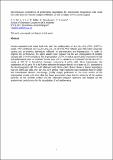Microstructure dependence of performance degradation for intermediate temperature solid oxide fuel cells based on the metallic catalyst infiltrated La- and Ca-doped SrTiO3 anode support
Abstract
Anode-supported solid oxide fuel cells with the configuration of the La0.2Sr0.25Ca0.45TiO3 (LSCTA-) anode, YSZ electrolyte and La0.8Sr0.2Co0.2Fe0.8O3 (LSCF)-YSZ cathode were fabricated using tape casting and co-sintering techniques followed by pre-reduction and impregnation. In order to improve the performance, the active anodes were prepared via the wet impregnation of metallic catalysts (Ni or Ni-Fe solution). The impregnation of 3 wt% nickel significantly improved the fuel cell performance from 43 mW cm-2 for the bare LSCTA- anode to 112 mW cm-2 for the Ni-LSCTA- anode at 700 °C in humidified hydrogen containing 3 vol% H2O. More interestingly, the substitution of 25 wt% Fe to Ni further enhances the power density by a factor of 1.5, compared to the Ni-impregnated cell. The cell infiltrated with Ni-Fe solid solution shows a slower degradation than the other two cells after the first 20 h period. High-resolution back-scattered electron (BSE) and transmission electron microscopy (TEM) images performed on the cross section of the impregnated anodes with time after ion beam preparation show that the sintering of the catalyst particles on the scaffold surface and the interaction between backbone and catalyst are the predominant contributions for the degradation of cell performance.
Citation
Ni , C , Lu , L , Miller , D N , Cassidy , M & Irvine , J T S 2018 , ' Microstructure dependence of performance degradation for intermediate temperature solid oxide fuel cells based on the metallic catalyst infiltrated La- and Ca-doped SrTiO 3 anode support ' , Journal of Materials Chemistry , vol. 6 , no. 13 , pp. 5398-5406 . https://doi.org/10.1039/C7TA09534A
Publication
Journal of Materials Chemistry
Status
Peer reviewed
ISSN
0959-9428Type
Journal article
Description
The research leading to these results has received funding from the European Union's Seventh Framework Programme (FP7/2007-2013) for the Fuel Cells and Hydrogen Joint Technology Initiative under grant agreement No. 256730 and Energy Technology Partnership (ETP). C. Ni also would like to thank the support from the Natural Science Foundation of China (NSFC, 51702264) Fundamental Research Funds for the Central Universities (XDJK2017B033) and Research Funding of Southwest University (SWU117019).Collections
Items in the St Andrews Research Repository are protected by copyright, with all rights reserved, unless otherwise indicated.

